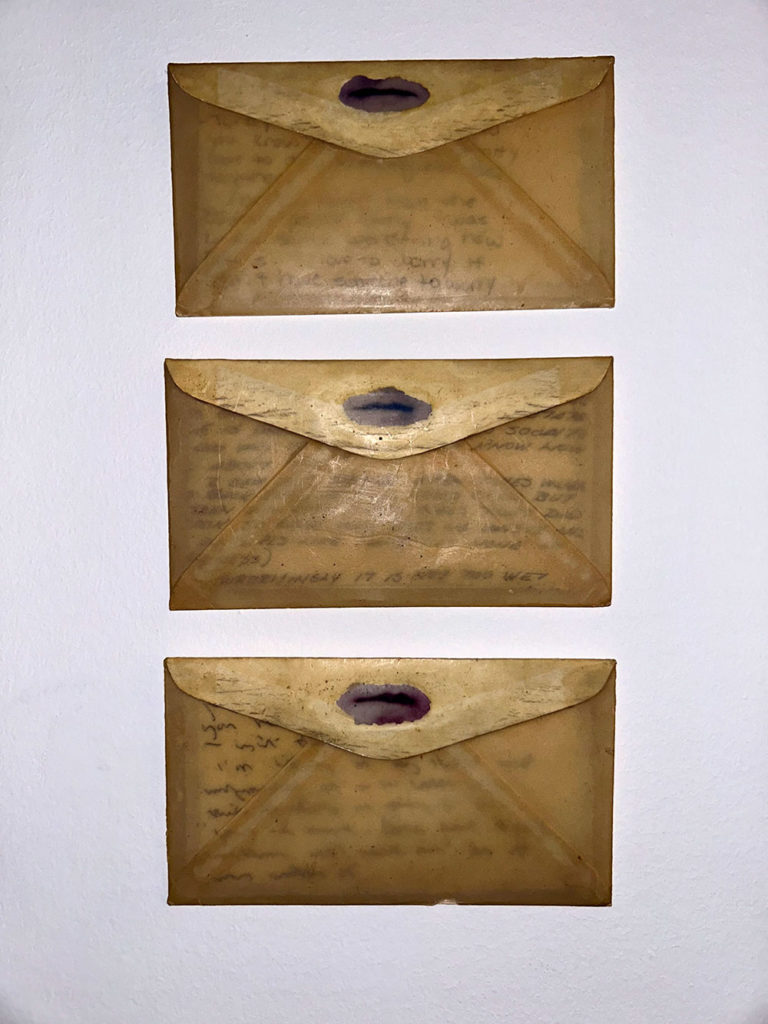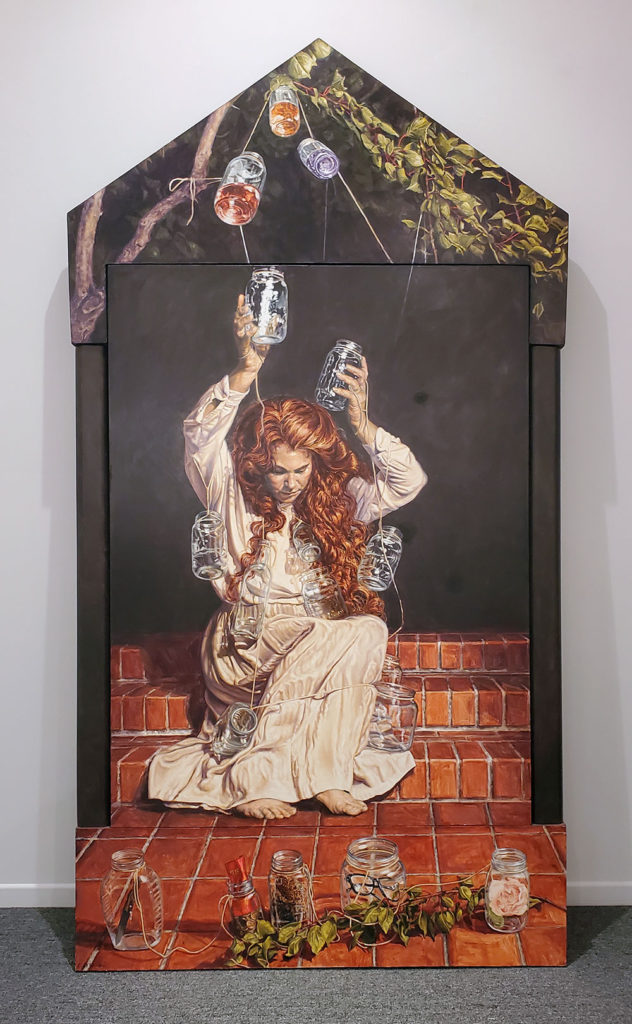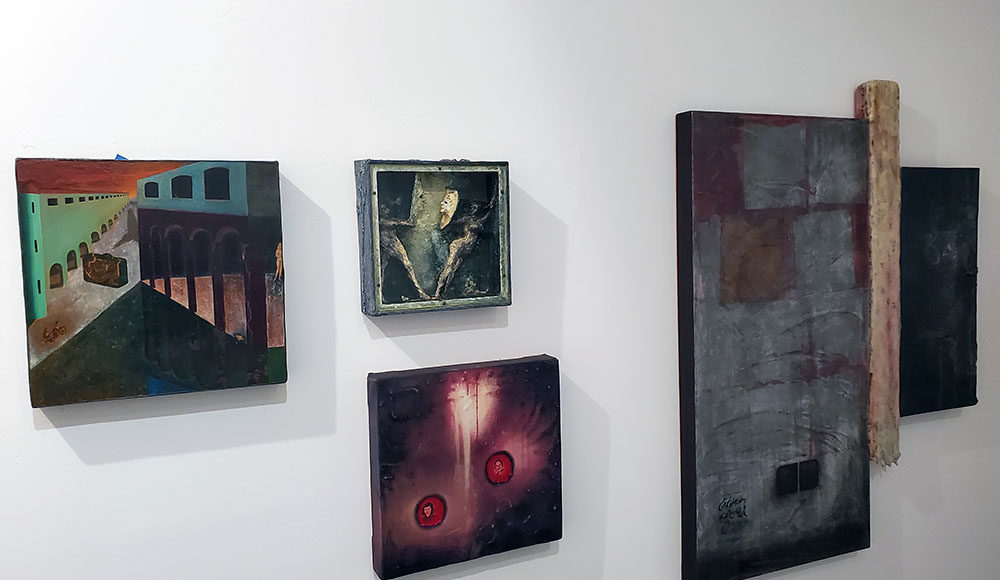Inside the Art Object Gallery in Japantown, Sheila Pickett points to a blown-glass tongue filled with medicinal herbs.
A conceptual piece by Bay Area Chicana artist Viviana Paredes, the tongue hangs on a wall, just one of more than 100 works of art collected over the years by Pickett’s late parents, Ralph and Sheila the elder. Ralph passed away in 2019, Sheila in 2023.
Ralph and Sheila were fixtures in the artist-collector-gallery nexus of San Jose for decades and left a formidable collection dating back to 1960, when they lived in New York. After moving to Saratoga in 1966, they continued to regularly purchase works from local artists.
Going back to the late 1970s, they helped support the ICA San Jose, WORKS and the San Jose Museum of Art, especially back when those institutions were pretty close to all San Jose had. Any visual artist with decades of South Bay experience is probably in the Picketts’ collection.
Now that both the elder Picketts are no longer with us, friends and family have sorted out the whole mess and curated a portion of the collection for view. FOR THE LOVE OF ART: The Ralph & Sheila Pickett Collection opens June 23, 3-6pm, at Art Object Gallery. A public auction will unfold on July 27, with proceeds benefiting the ICA San Jose, where the Picketts served on the board years ago.
Map of the Art Scene
During my advance infiltration of the exhibit, many of the works are still being installed. Titles and various pieces of tape and sticky notes are tacked askew on the walls. Some of the works are still boxed up. Tables and carts with tools are scattered throughout.
The Paredes piece in question was originally part of an installation she created, My Pocha Tongues, made with glass and traditional herbs used to heal the breath, lungs and mouth. Paredes was exploring her own development with the Spanish language and her guilt at not becoming fluent until later in life.
“This whole installation that she did with all these different tongues was very a cathartic process for her to express this experience,” Pickett tells me, pointing to the piece on the wall. “I just love that because, well, one, it was a new thing, new information for me about that piece. I felt it so represented what my parents were interested in with conceptual art, and art that talks about the human experience. Even when they talked about their collection, they kept talking about pieces that communicated something about the human experience.”
The Picketts’ collection included many locals, but also many internationally renowned artists. The work on display at Art Object Gallery features a cross-section. As Sheila continues to show me around, she points to several pieces, each one of which comes with a story about why her parents bought the piece in the first place—the mark of a true collector.

I recognize several local folks in the collection. Bev Rayner. Erin Goodwin Guerrero. Stephanie Metz. Harry and Lynn Powers. Tessie Barrera-Scharaga. Tony May, Joe Miller and Al Preciado.
An earthy ceramic sculpture by Robert Milnes, who chaired the SJSU Art Department back in the 1990s, sits right inside the doorway. The Model is based on Brancusi’s Mademoiselle Pogany, with an allusion to both the hookah-smoking caterpillar in Alice’s Adventures Through the Looking Glass and also Chinese Buddhist sculptures. A Wittgenstein quote in Morse code is on the back of the head. It says, “A picture is a model of reality.”
Much of the show feels like a history of the San Jose art scene, young and old, past and present, academic and non-academic, alive or dead.
Rayner’s piece, for example, deals with memory, a subject the Picketts really loved. As we wander down the hall of the sweltering metal-roof gallery, where many of the works are still covered up, Pickett points to Rayner’s mixed media conceptual work of photographs, beeswax and paper envelopes: Letters Never Sent—part of the artist’s Human Nature series.
“This was one of the early ones I remember my mom talking about,” Sheila says. “And the way Bev would create these works that so spoke to the longing for those who have gone before. I know in my mom’s mind it was her own parents. And so that memory shows up in a lot of these, that concept of memory, and the fading memory, and what’s left.”
Yet there are several international works. New Future, by Danish artist Emile Westman Hertz (1978-2016), for example, features a head organically constructed within a beehive, so that the live bees eventually built up the surface of the work as if it was a honeycomb. The work is a comment on the body’s constant state of disintegration and reconstruction.
Westman Hertz died young and was sick much of his adult life. He was still alive when the Picketts purchased the work.
Fingers on the Pulse
Kathryn Funk first started directing the ICA San Jose in 1989, right as Ralph Pickett was starting to serve on the board. She told me the Picketts were everywhere in those days.
“Their influence was subtle yet very important,” she said, adding that the Picketts were not only regular participants in the art auctions held annually by ICA and WORKS, but also keenly in tune with the rest of the Bay Area art scene. “I could count on them to tell me of an artist I may have missed during open studios,” she continued. “They would also tell me of exhibitions in San Francisco that I shouldn’t miss. If there was any visual art event happening—receptions, lectures, auctions—we could count on them to be there.”
When Sheila the younger contacted Funk to help sort through the remaining collection, Funk was unsure what to do with the many artworks that the immediate family could not absorb. Everyone genuinely wanted to honor the late collectors, somehow.
“Reviewing the collection again after so many years and seeing so many new works, I felt it would be a shame not to be able to share it with the San Jose community,” Funk said.
Funk then contacted Ken Matsumoto, proprietor of Art Object Gallery, and whose own sculptures were purchased by the Picketts many times over the years. Together, everyone felt that dispersing the collection via some external auctioneer just didn’t feel like a proper honoring of the Picketts’ legacy in the community. After discussing the possibilities, Matsumoto agreed on a show. Sheila the younger approved and the process began.

In helping to curate the exhibit, Funk chose to include works by local artists first, then added those that Ralph and Sheila collected from artists based in other cities and countries. Admittedly, sorting it all out was a tough process, since the collection was vast. Over the years, the Picketts had graduated from conventional artworks to works that pushed boundaries in terms of materials and concepts. They were interested in ideas. They wanted works that said something, works that questioned the status quo.
“I think we’ve shown the transition from conventional to the more provocative ideas,” Funk said. “The Picketts had a great sense of humor that comes through as well.”
Shared Experiences
Sheila the younger and I reach the end of the hallway at Art Object Gallery, where a fantastic painting, Bottle Tree by Katherine Levin Lau, leans up against the wall, ready for hanging. It was one of the early pieces the Picketts nabbed when they really threw themselves into collecting original artwork. At the time, Lau hadn’t even finished the painting yet. She was working on it in her studio when the Picketts came over and said, “That’s the one we want.”
Bottle Tree depicts a woman putting all her worries into glass jars and then sending them up to be protected. The Picketts loved the concept.
“My parents just felt like this was a great articulation of, or a depiction of, what that’s like. To have all those worries and to try to be juggling them all and taking them to get taken care of and putting them up there to be taken care of.”
As we both continue through the space, taking in the collection, in various stages of installation, Sheila corroborates many of the stories and memories of her parents relayed by Funk, in regards to the Picketts’ overall dedication to the San Jose arts community. Even though her parents started out in Long Island—the first piece they bought in 1960 was a print by Johnny Friedlaender—they eventually grew into a serious force in the South Bay. They became more and more interested in artworks that expressed something about the human experience, gradually focusing on original works as opposed to prints. They were interested in concepts and even spiritual expression via the visual arts.
Most of all, they showed up to everything. They went to SJSU student shows every single Tuesday. Off campus, they attended all the high-end parties. They were everywhere. As a kid, Sheila realized her parents were local celebrities in the art world.
“Them sharing that experience with us and also going to those galleries, I realized I’m tagging along with the cool kids,” she told me. “And that was a whole new experience as I got older. I certainly never felt that way when I was a teenager, but they really just got so much out of the art community. They enjoyed it so much. It was so much a part of their engagement with the community, and they just loved it.”
Now a piece of the Picketts, or several pieces, will disperse throughout the land. Their legacy will endure.
For the Love of Art opens June 23 with a 3–6pm reception at Art Object Gallery, 592 N 5th St, San Jose; 408.288.9305. The silent auction takes place July 27, 6–9pm.




The Pickets knew the inherent value of the arts to life and community. Their support and involvement with the San Jose arts community has had a lasting effect. Grateful to see this honoring of their dedication.
Ralph and Sheila Pickett have left their mark on our community. Thank you for writing about them, their collection, and the exhibition.